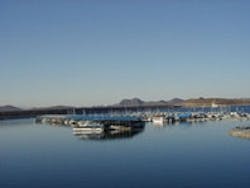American Water Takes Steps to Address the Needs of Arizona's Growing Population
American Water, the largest water services provider in North America, is addressing the needs of Arizona's growing population through an environmentally-conscious project designed to provide reliable drinking water, all while meeting existing and foreseeable future regulations and responding to regional growth. The Lake Pleasant Water Treatment Plant, the result of a successful public-private partnership between American Water and the city of Phoenix, is expected to begin operations this spring upon completion of the first phase of a four-phase project.
The largest design-build-operate (DBO) facility of its kind in North America, the Lake Pleasant Water Treatment Plant has helped the city of Phoenix earn accolades as the best-managed city in the country. Encompassing 225 acres, yet displaying an architectural style that naturally blends with the desert landscape, the Lake Pleasant Water Treatment Plant treats water from Waddell Canal, pumping it through a 90-in. diameter pipeline approximately 12,000 ft in length. Treated water is then stored in a 40 million-gal, partly buried finished-water storage reservoir and transferred to the city's high and low pressure distribution systems by an onsite pump station.
“Partnerships between municipalities and the private sector are becoming increasingly effective strategies for addressing the critical challenges of supply and demand,” said Don Correll, president and CEO of American Water. “The Lake Pleasant Water Treatment Plant is a prime example of a public-private partnership that is working to solve the complex environmental issues facing municipalities today.”
American Water was awarded the $336 million DBO contract in August 2003 to serve as the prime contractor and to additionally manage and operate the facilities for the first 15 years. Construction of the 80 mgd plant, one that will ultimately service 400,000 households, began in the summer of 2004.
John Quarendon, American Water DBO program director and project director for the Lake Pleasant Water Treatment Plant in Phoenix, Ariz., participated in a panel to discuss the project at the 2007 Design-Build Water/Wastewater Conference in Seattle, Wash. on Feb. 15. The panel will comprise two executives from the city of Phoenix and the regional presidents of both Black and Veatch Corporation and McCarthy Building Companies, Inc., two of the project's key contributors, who will discuss the project's many community benefits, as well as its challenges.
“The Lake Pleasant Water Treatment Plant has been an exciting venture for all of us,” said Quarendon. “To be able to discuss such a unique project at the DBIA Conference will allow others to recognize the importance of a team-oriented approach to solving today's complex water-supply challenges.”
Organized by the Design-Build Institute of America, the water/wastewater conference is an opportunity for industry leaders to converge and explore the hallmarks of integrated project delivery, while sharing the realities and learning new integrated strategies. Held at the Seattle Airport and Conference Center, the conference will focus on current issues, best practices and challenges facing officials in the water/wastewater design-build industry.
The Lake Pleasant Water Treatment Plant is one of several successful public-private partnerships between American Water and local municipalities. Others include the city of Buffalo, the Tolt Treatment Facility in Seattle, Wash. and Gillette Stadium in Foxboro, Mass.
Source: American Water
